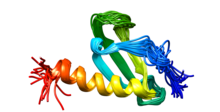CXCL14
| chemokine (C-X-C motif) ligand 14 | |||||||
|---|---|---|---|---|---|---|---|
| Identifiers | |||||||
| Symbol | CXCL14 | ||||||
| Alt. symbols | SCYB14, BRAK, NJAC, bolekine, Kec, MIP-2g, BMAC, KS1 | ||||||
| NCBI gene | 9547 | ||||||
| HGNC | 10640 | ||||||
| OMIM | 604186 | ||||||
| PDB | 2HDL | ||||||
| RefSeq | NM_004887 | ||||||
| UniProt | O95715 | ||||||
| Other data | |||||||
| Locus | Chr. 5 q31 | ||||||
| |||||||

Chemokine (C-X-C motif) ligand 14 (CXCL14) is a small cytokine belonging to the CXC chemokine family that is also known as BRAK (for breast and kidney-expressed chemokine).[1] Mature CXCL14 has many of the conserved features of the CXC chemokine subfamily but has some differences too, such as a shorter N-terminus and five extra amino acids in the region between its third and fourth cysteines.[1] CXCL14 is constitutively expressed at high levels in many normal tissues, where its cellular source is thought to be fibroblasts.[2] However, it is reduced or absent from most cancer cells.[1][3] This chemokine is chemotactic for monocytes and can activate these cells in the presence of an inflammatory mediator called prostaglandin-E2 (PGE2).[2] It is also a potent chemoattractant and activator of dendritic cells, is implicated in homing of these cells,[4] and can stimulate the migration of activated NK cells.[5] CXCL14 also inhibits angiogenesis, possibly as a result of its ability to block endothelial cell chemotaxis.[6] The gene for CXCL14 contains four exons and is located on chromosome 5 in humans.[1]
References
[edit]- ^ a b c d Hromas R, Broxmeyer HE, Kim C, Nakshatri H, Christopherson K, Azam M, Hou YH (February 1999). "Cloning of BRAK, a novel divergent CXC chemokine preferentially expressed in normal versus malignant cells". Biochemical and Biophysical Research Communications. 255 (3): 703–6. doi:10.1006/bbrc.1999.0257. PMID 10049774.
- ^ a b Kurth I, Willimann K, Schaerli P, Hunziker T, Clark-Lewis I, Moser B (September 2001). "Monocyte selectivity and tissue localization suggests a role for breast and kidney-expressed chemokine (BRAK) in macrophage development". The Journal of Experimental Medicine. 194 (6): 855–61. doi:10.1084/jem.194.6.855. PMC 2195966. PMID 11561000.
- ^ Frederick MJ, Henderson Y, Xu X, Deavers MT, Sahin AA, Wu H, Lewis DE, El-Naggar AK, Clayman GL (June 2000). "In vivo expression of the novel CXC chemokine BRAK in normal and cancerous human tissue". The American Journal of Pathology. 156 (6): 1937–50. doi:10.1016/S0002-9440(10)65067-5. PMC 1850081. PMID 10854217.
- ^ Shurin GV, Ferris RL, Ferris R, Tourkova IL, Perez L, Lokshin A, Balkir L, Collins B, Chatta GS, Shurin MR (May 2005). "Loss of new chemokine CXCL14 in tumor tissue is associated with low infiltration by dendritic cells (DC), while restoration of human CXCL14 expression in tumor cells causes attraction of DC both in vitro and in vivo". Journal of Immunology. 174 (9): 5490–8. doi:10.4049/jimmunol.174.9.5490. PMID 15843547.
- ^ Starnes T, Rasila KK, Robertson MJ, Brahmi Z, Dahl R, Christopherson K, Hromas R (August 2006). "The chemokine CXCL14 (BRAK) stimulates activated NK cell migration: implications for the downregulation of CXCL14 in malignancy". Experimental Hematology. 34 (8): 1101–5. doi:10.1016/j.exphem.2006.05.015. PMID 16863917.
- ^ Shellenberger TD, Wang M, Gujrati M, Jayakumar A, Strieter RM, Burdick MD, Ioannides CG, Efferson CL, El-Naggar AK, Roberts D, Clayman GL, Frederick MJ (November 2004). "BRAK/CXCL14 is a potent inhibitor of angiogenesis and a chemotactic factor for immature dendritic cells". Cancer Research. 64 (22): 8262–70. doi:10.1158/0008-5472.CAN-04-2056. PMID 15548693.
